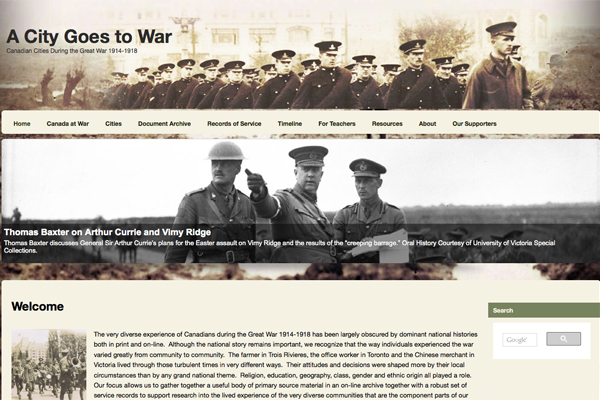Online archive sheds light on Victoria’s war history
By Lookout on Nov 04, 2013 with Comments 3
An in-depth look at Victoria during World War One is now just a click away.
A new website titled “A City Goes to War” was conceived by University of Victoria (UVic) PhD student and retired Princess Patricia’s Canadian Light Infantry (PPCLI) Colonel Jim Kempling.
“I thought about how a lot of Victoria’s history from World War One has been forgotten,” says Col Kempling. “On Remembrance Day, we all say ‘we will remember them.’ The truth is we have forgotten. I wanted to help people remember what happened in Victoria.”
The website comprises historical articles, timelines, and service records that show the many significant events, both good and bad, that took place in Victoria during the conflict.
“We always talk about how Canada was ‘born on the bloody slopes of Vimy Ridge’, but we never talk about how there were anti-German riots in Victoria,” says Col Kempling. “Racism was rampant at the time. The Asian population in British Columbia wasn’t even allowed to join the military, they had to make their way to Alberta or further. These are things we’ve completely forgotten about.”
Victoria was also home to significant figures during the First World War, another fact often forgotten.
“Sir Arthur Currie, Commander of the Canadian Corps, was a school teacher and real estate agent in Victoria before World War One,” says Kempling. “Many people in Victoria have forgotten that, but it’s a big part of our history.”
The website, besides being an online archive, also offers a teaching package aimed at educating high school students on The Great War. The package includes assignments to encourage students to make what’s called a “Fakebook”, essentially a fictional social media page for a historical figure.
“We want kids to be aware of the history of their town,” says Col Kempling. “Hopefully this will be an effective way of making it more appealing to them.”
He says while certain portions of Victoria’s history may not paint the city in the brightest light, it’s a part of our history none-the-less.
“Forgetting about it doesn’t make it go away,” he says. “If we’re going to learn from our mistakes and make a better future we have to be aware of what happened in the past.”
In assembling the site, Col Kempling had help from a number of undergraduate and graduate students. One such student was Kirsten Hurworth, a History and English double major at UVic currently in her fourth year.
“My professor told me about the project following a paper I’d written about English/Canadian children during World War One,” says Hurworth. “They took me on and I spent my summer putting together content.”
The content was assembled through extensive interviews and research with the Canadian Scottish and Artillery regiments at Bay Street Armoury, Alden Armoury, and Fort Rodd Hill.
Hurworth’s articles are included in the site’s packages, as well as interviews and research papers on facets of the city’s history.
“Victoria has such a rich and strong history a lot of people have forgotten about,” says Hurworth. “It was a pleasure, and an honour, to be a part of the efforts to preserve and share it with the community.”
The website can be found at www.acitygoestowar.com
Shawn O’Hara, Staff Writer
Filed Under: Top Stories
About the Author:







The regiments of Canada were drawn from men and women of all parts of this city. Our history is not so much the story of a person, yet a people who gave, served and took honour in the duty, commitment to ensure future Victorian were able to read there story today.
I hope nobody forgets to mention that at the outbreak of WW1, the Canadian Submarine Sevice was born with the purchase of Submarines CC1 and CC2. These were initially procured by the government of BC at the time of imminent hostilities and the threat of (or fear of) Victoria being obliterated by a German Cruiser steaming north at the time from South America. It is actually avery fascinating story.
Not to mention neighbouring Esquimault, base of the Royal Canadian Navy on the west coast, home to HMCS Rainbow and the subs C1 and C2 which readied themselves to fight Admiral Graf Von Spee’s Pacific Squadron — one cruiser of which appeared to be on the way to attack. It is almost certain had HMCS Rainbow intercepted it — and it was prepared to do so — it would have been destroyed, as it carried mostly practice shells and had a largely untrained crew that was only just learning the ropes. The captain of Rainbow had to have been pretty nervy. As for the submarines, their history is kind of unusual too. First of all they were being built in Washington State for the Chilean Navy. The premier of BC went to Washington state and arranged to purchase them from provincial coffers (generally the federal government would make such purchases but the premier felt time was of the essence) — and did so in secret. The subs were brought to Esquimault (towed, I think as Canada had no trained sub crews yet) and then offered to the Royal Canadian Navy. The Chileans were furious that their subs had been essentially pilfered from them. However, their presence may have played a part in preventing a German attack on Canada’s west coast. The Juan de Fuca Strait is a labyrinth of channels and islands and good hiding places for submarines, and the risk of being hit by torpedoes in such narrow waters may have been a threat the Germans weren’t willing to take on, especially since they had no facilities nearby for thousands of miles. Later on, Japan’s navy (our allies in World War 1) took over the task of protecting Esquimault from enemy action but by then the German threat was over.